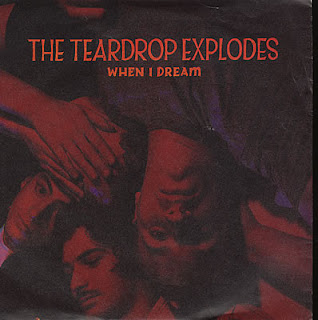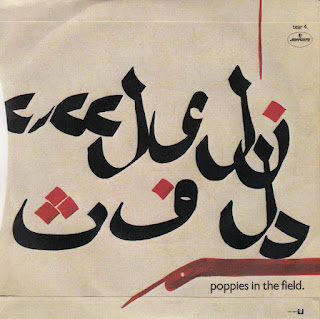When I Dream
Julian Cope - bass, vocals
David Balfe - keyboards
Mick Finkler - guitar
Gary Dwyer - drums
Version two - BBC Session for John Peel, recorded 16th April 1980, available on "Peel Sessions Plus" and "Kilimanjaro" deluxe edition.
Julian Cope - bass, vocals
David Balfe - keyboards
Mick Finkler - guitar
Gary Dwyer - drums
Version three - recorded Summer 1980, released October 1980
Version 3a - released on "When I dream" 7" single, September 1980 and "The Greatest Hit" compilation CD, 2000 *
Version 3b - released on "Kilimanjaro" album, October 1980 and US Skyclad "Kilimanjaro" CD, 1988.
Version 3c - released on "Kilimanjaro" reissue ("Zebra" cover), Spring 1981
Version 3d - released on later pressings of "Kilimanjaro" from 1984 onwards, and on subsequent CD issues of the album.
* Actually the single edit is 30 seconds shorter than the version on "The Greatest Hit" and there's a "video" version which is 15 seconds shorter than the single edit but bloody hell how many more versions do I need to list? Thanks Keir Hardie for helping me on this voyage of discovery.
Julian Cope - bass, vocals
David Balfe - keyboards
Alan Gill - guitar
Gary Dwyer - drums
Written by Cope / Dwyer / Finkler
At the start of 1980 the Teardrop Explodes were definitely building up a reputation based on their two Zoo singles and first Peel session, they were close to signing a publishing deal which would give them a steady income and allow them to turn "professional" and they had "Treason" waiting in the wings, a perfect pop song and surefire hit at some point in the future. But there were more troubles too. Echo and the Bunnymen were ahead of them in the race for a major record label deal and were on the verge of recording their debut album. So "When I dream" could not have been written at a better time. Another perfect pop song, another future hit (hopefully) and another song to entice a major label deal.
The song originates from the three note bass line written by Cope. He had been listening to the Seeds - one of the ultimate 60s bands to build songs around simple two or three note riffs. This was more at the tempo of "Can't seem to make you mine" instead of the speedfreak mania of "Pushin' too hard". Cope repeated the riff in rehearsal, Finkler added guitar chords, Dwyer found a drum pattern which suited it, and Balfe added a tinkling toy piano melody, a hint of sweetness which Cope would pick up on when he wrote the lyrics quickly. It was that most un-Teardrop of song subjects - love. It's well known that "Passionate Friend" was written by Cope about his relationship with Julie McCulloch - sister of Ian - and he always stated there was an earlier Teardrops song about her, and I suspect it was "When I dream". (Of course he's also said "Bandy's first jump" is about her but that was written pre-Teardrops apparently. Hmm).
"When I dream" seems to be a 1980 song, I can find no evidence of it played live in 1979 - not even in the Teardrops' final show of the year, a co headliner with Echo and the Bunnymen at Eric's. As such it was relatively fresh when they recorded it at Rockfield in March 1980 for their debut album. This recording is available on both "To the shores of Lake Placid" and "Zoology" and is the only evidence of what "Everybody wants to shag The Teardrop Explodes" might have sounded like had it been considered good enough for release on Zoo Records during the summer of 1980. There's very little in the way of effects on the song - Cope's vocal sounds tentative without any reverb or delay, Finkler's chunky guitar riffs don't really progress anywhere except in the fade out, the synth sounds more toylike than ever and Dwyer's tomtom rolls (spread across the stereo spectrum) soon become annoying. It sounds bland, blank and not really that good. Almost everything is there, but it's not had a polish, or much thought given to it.
The second recording - for their second Peel session a month after the LP sessions - is a little slower, a little more forceful (Cope's vocal and bass are more upfront and there's some double tracking on the vocal in places) and at least it has an ending of some kind unlike the Rockfield version which just fades out. It is still lacking a certain something.
That certain something was provided by two people. Alan Gill and Mike Howlett. Mick Finkler's replacement with Alan Gill - as I have said many times already - was a huge catalyst for the band, bringing in a very capable guitarist with the confidence to introduce a truly psychedelic edge to the band, as we will see on the next blog post. I've never been sure why Mike Howlett was brought in to produce two songs on "Kilimanjaro" but it certainly helped. During the summer of 1980 Howlett was riding high on the back of OMD's first hit single (a rerecording of "Messages" from their debut) and about to embark on production duties on their second album "Organisation". Not bad for the bass player from Gong. Anyway, Howlett had the magic touch that summer and applied it to the third recording of "When I dream".
Now this is where it all gets a little bit complicated because there have been four versions of this track issued over the years. First out of the traps in September 1980 was the single mix - their first single for Mercury - which fades out at 3 mins 44 seconds. A longer mix of this appeared on the first edition of "Kilimanjaro" a month later which fades out around the five minute mark. When the album was reissued in 1981 "When I dream" was remixed and Cope proudly claimed it was a "version where I play very low synth at the end, which I'd always wanted to come out", and yet this version is only 44 seconds longer than the original album version. And just to add to the confusion, at some point in the early 80s this version was replaced by the 7 minutes and 10 seconds version which is most well known. This is the version I heard on the mid price reissue of "Kilimanjaro" I bought in 1985 and has appeared on any subsequent CD reissues.
And yet all four versions are basically the same recording with a few tweaks here and there, mostly towards the end of the song. It all kicks off with a nice tomtom roll from Dwyer before the whole band come in, and already it sounds tighter, faster, better. The synth melody swims above the rhythm section of Dwyer, Cope and Gill for the intro before the first verse and already there's a huge difference. During the chorus Gill plays arpeggios to fill out the sound but in the verses lets guitar harmonics ring out, before moving into more arpeggios in the bridge into the chorus. There's more variety in the keyboards too, little fills here and there, dropping synth sounds, there's always something interesting happening. Even Dwyer's drum patterns are more invigorating and vital, turning the beat around during the instrumental sections of the chorus. There's even a breakdown highlighting Cope's vocal, Gill's bent harmonics and Dwyer's drums while little noises are added here and there. Cope's vocal is much improved too, and there's double tracking and harmonies here and there which helps immensely. It all sounds like a perfect pop song, even with little oriental swerves such as the little section after the second verse. After three minutes everything that needs to happen has happened and extra vocal melodies from elsewhere in the song are spun in alongside additional synth melodies, and slowly the song fades into the distance over the remaining few minutes (depending on which version you're listening to, of course). The full seven minute version is probably my favourite, highlighting Gill's remarkable guitar arpeggios and Balfe's layered synths. It's truly hypnotic and a great way to close the album.
However not everyone approved of the song's choice to lead the album campaign. Newly assigned publicist Mick Houghton thought it was the wrong song for the time. He felt that it didn't have the wit or charm of previous singles, but Phonogram A&R man David Bates thought it was a hit single, and so did Cope. Somebody had enough faith in it to allow the band to make a promotional video for it (see above), a peculiar performance clip highlighting Cope over the other members and showing the zebra backdrop they would use on their Autumn 1980 tour. And is that an ARP Quadra that Balfe is playing? Nice!
"When I dream" was released with hope in September 1980 and received mixed reviews. It was slaughtered by Dave McCulloch in Sounds, he thought it was "a bit worrying", seeming to expect something earth shattering and life changing from the band. He claimed it was a "decidedly dodgy choice at an important time" and that he'd been playing a tape of the album for six months... (We'll come back to that soon) At least Record Mirror liked it and made it Single Of The Week, and Smash Hits thought it was a "richly textured tuneful keyboard ballad". So some people liked it.
This was the first song I heard by The Teardrop Explodes. I remember it being played a lot on Mike Read's show on Radio 1 at the time, and possibly on the breakfast show too. I certainly saw it when the Teardrops appeared on Swap Shop to promote the single. The band are bathed in red light, Cope is upfront in his leather flying jacket and commanding the camera - he has no bass guitar to get in his way as he's miming - and it's his band, he's in control. Balfe gets an occasional close up (and stares into the camera at one point) but Gill hangs to the side, cool in his bandana, while Dwyer is just Dwyer. Are they on drugs? Probably not for this performance but who knows?
The TV and radio promotion didn't help the single though. It crept into the charts at the end of September and climbed to the dizzy heights of number 47 a few weeks later. This may have been impressive for a band's first single on a major label after three independent releases, but David Bates was probably expecting better and / or more. And maybe the music press were expecting more too.
"When I dream" was quite a popular song in the band's live set. It was featured regularly during 1980 gigs and played often during 1981 dates too, though mostly on their US tour early in the year. It dropped out of the set as newer songs emerged. However it wasn't forgotten. The Mighty Lemon Drops recorded a version for a Janice Long session in 1986 and played it live a few times too (it must have made a change from playing "Paint it black" in the style of the Bunnymen). They still manage to fuck it up though, making it sound more "Gloria" then anything else (there's more than two chords in the song, you know) Even Pete Paphides played the full album version on his Soho Radio show a few years ago, tweeting "Yes I'm playing the entire two minute fade of The Teardrop Explodes' When I Dream", to which I replied "And quite right too!" Sometimes more is more. The seven minute version is my favourite version of the song, it really is a prime example of "bubblegum trance".



Comments
Post a Comment